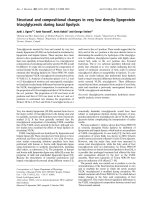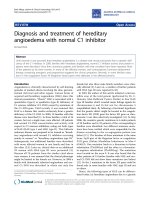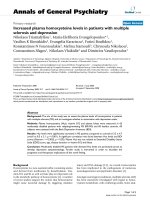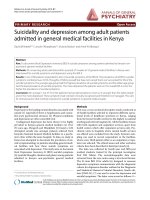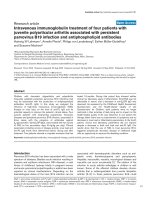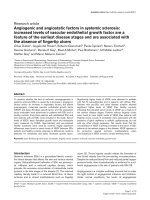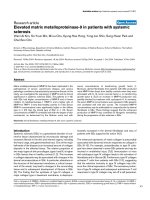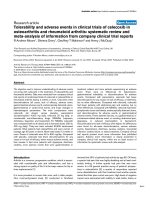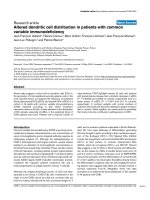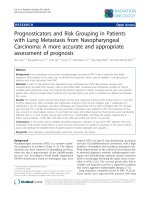Báo cáo y học: "Copeptin and risk stratification in patients with acute dyspnea" ppsx
Bạn đang xem bản rút gọn của tài liệu. Xem và tải ngay bản đầy đủ của tài liệu tại đây (634.73 KB, 9 trang )
RESEARC H Open Access
Copeptin and risk stratification in patients with
acute dyspnea
Mihael Potocki
1*
, Tobias Breidthardt
2
, Alexandra Mueller
2
, Tobias Reichlin
1
, Thenral Socrates
2
, Nisha Arenja
2
,
Miriam Reiter
2
, Nils G Morgenthaler
3
, Andreas Bergmann
3
, Markus Noveanu
1
, Peter T Buser
1
,
Christian Mueller
2
Abstract
Introduction: The identification of patients at highest risk for adverse outcome who are presenting with acute
dyspnea to the emergency department remains a challenge. This study investigates the prognostic value of
Copeptin, the C-terminal part of the vasopressin prohormone alone and combined to N-terminal pro B-type
natriuretic peptide (NT-proBNP) in patients with acute dyspnea.
Methods: We conducted a prospective, observational cohort study in the emerge ncy department of a university
hospital and enrolled 287 patients with acute dyspnea.
Results: Copeptin levels were elevated in non-survivors (n = 29) compared to survivors at 30 days (108 pmol/l,
interquartile range (IQR) 37 to 197 pmol/l) vs. 18 pmol/l, IQR 7 to 43 pmol/l; P < 0.0001). The areas under the
receiver operating characteristic curve (AUC) to predict 30-day mortality were 0.83 (95% confidence interval (CI)
0.76 to 0.90), 0.76 (95% CI 0.67 to 0.84) and 0.63 (95% CI 0.53 to 0.74 ) for Copeptin, NT-proBNP and BNP,
respectively (Copeptin vs. NTproBNP P = 0.21; Copeptin vs. BNP P = 0.002). When adjusted for common
cardiovascular risk factors and NT-proBNP, Copeptin was the strongest independent predictor for short-term
mortality in all patients (HR 3.88 (1.94 to 7.77); P < 0.001) and especially in patients with acute decompensated
heart failure (ADHF) (HR 5.99 (2.55 to 14.07); P < 0.0001). With the inclusion of Copeptin to the adjusted model
including NTproBNP, the net reclassification improvement (NRI) was 0.37 (P < 0.001). An addit ional 30% of those
who experienced events were reclassified as high risk, and an additional 26% without events were reclassified as
low risk.
Conclusions: Copeptin is a new promising prognostic marker for short-term mortality independently and additive
to natriuretic peptide levels in patients with acute dyspnea.
Introduction
Acute dyspnea is a frequent clinical presentation in the
emergency department (ED). Cardiac and pulmonary
disorders account for more than 75% of patients pre-
senting with acute dyspnea to the ED [1,2]. The iden tifi-
cation of acute dyspneic patients at highest risk for
death, particularly regarding short-term mortality
remains a challenge. Patient history and physical exami-
nation remain the cornerstone of clinical evaluation [3],
while disease specific scoring tools [4,5] and biomarkers
such as natriuretic peptides have been introduced to
assist the clinician in the diagnostic and prognostic
assessment [6-10].
The arginin-vasopressin system plays a crucial role in the
regulation of the individual endogenous stress response
[11]. Levels of arginin-vasopressin have been shown to be
elevated in hea rt failure [12] an d in different states of
shock [13], but investigation of the vasopressin system was
limited so far due to the fact that vaso pressin is unstable
(half-life 5 to 15 minutes) and largely attached to platelets
[14,15]. Copeptin, the c-terminal part of the vasopressin
prohormone, is secreted stoichiometrically with vasopres-
sin from the neurohypophysis and is much more stable,
thus overcomin g the limitations and difficulties assessing
* Correspondence:
1
Department of Cardiology, University Hospital, Petersgraben 4, Basel, 4031,
Switzerland
Full list of author information is available at the end of the article
Potocki et al. Critical Care 2010, 14:R213
/>© 2010 Potocki et al.; licensee BioMed Central Ltd. This is an open access article distributed under the term s of the Creative Commons
Attribution Lice nse ( y/2.0), which permits unrestricted use, distribu tion, and reproduction in
any medium, provided the original work is properly cited.
the arginin-vasopressin-system [16]. Recently, several stu-
dies investigated the prognostic role of Copeptin in various
diseases [17-23], but little is known about the prognostic
value of Copeptin in a typical ED population, for example,
the patient group admitted with acute dyspnea. In clinical
practice, the identification of dyspneic patients at highest
risk for adverse outcome remains challenging. Therefore,
we tested the prognostic value of Copeptin together with
established markers such as BNP and NT-proBNP in an
effort to better understand the role of Copeptin in this
setting.
Materials and methods
Study population
The study population consisted of unselected patients
presenting to the emergency department of the Univer-
sity Hospital of Basel, Switzerland, with a chief com-
plaint of acute dyspnea. From April 2006 to March
2007, 292 patients (out of 327 patients screened) were
prospectively enrolled. Exclusion criteria were age
younger than 18 years, an obvious traumatic cause of
dyspnea and patients on haemodialysis. 287 of the 292
patients had complete copeptin data at presentation and
were considered as the study population. The study was
carried out according to the principles of the Declara-
tion of Helsinki and approved by the local ethics com-
mittee. Written informed consent was obtained from all
participating patients.
Clinical evaluation and follow-up
Patients underwent an initial clinical assessment includ-
ing clinical history, physical examination, electrocardio-
gram, pulse oximetry, blood tests including BNP, and
chest X-ray. Echocardiography, pulmonary function tests
and other diagnostic tests like CT-angiography were
performed according to the treating physician. CT-
angiography was the imaging modality of choice in
patient s with suspe cted pulmonary embol ism. To assess
the dyspnea severity we used the NYHA (New York
Heart Association) classification with NYHA II as ‘dys-
pnea while walking up a slight incline’, III as ‘dyspnea
while walking on level ground’ and IV as ‘dyspnea at
rest’.
Two independent internists blinded to Copepti n
reviewed all medical records including BNP levels and
independently classified the patient’s primary diagnosis
into seven ca tegories: acute decompensated heart failure
(ADHF), acute exacerbation of chronic obstructive pul-
monary disease, pneumoni a, acute complications of
malignancy, acute pulmonary embolism, hyperventila-
tion, and others. In the event of diagnostic disagreement
among t he internist reviewers, t hey were asked to meet
to come to a common conclusion. In the event that
they were unable to come to a common conclusion, a
third-party internist adjudicator was asked to review the
data and determine which diagnosis was the most
accurate.
The endpoint of the present study was defined as 30-
day all-cause mortality. Each patient was contacted for
follow-up, via telephone, by a single trained researcher
after 30 days. Regarding mortality data, referring physi-
cians were contacted or the administrative databases of
respective hometowns were r eviewed, if necessary. Of
note, one patient was lost to follow-up, so mortality
analyses were performed in 286 patients.
Laboratory measurements
Blood samples for determination of Copeptin, BNP and
NT-proBNP were collected at presentation into tubes
containing potassium EDTA. After centrifugation, sam-
ples were frozen at -80°C until assayed in a blinded
fashion in a single batch using a novel commercial sand-
wich immunoluminometric as say (B.R.A.H.M.S LUMIt-
est CT-proAVP, BRAHMS AG, Hennigsdorf/Berlin,
Germany) as described in detail elsewhere [16]. Since
this initial publication, the assay was modified as fol-
lows: The capture antibody was replaced by a murine
monoclonal antibody directed to amino acids 137 to 144
(GPAGAL) of pro-Arginin-Vasopressin. This modifica-
tion improved the sensitivity of the assay. The lo wer
detection limit was 0.4 pmol/L and the functional a ssay
sensitivity (< 20% inter assay CV) was <1 pmol/L. Med-
ianCopeptinlevelsin200healthy individuals was 3.7
pmol/l and the 97.5
th
percentile was 16.4 pmol/L. NT-
proBNP levels were determined in a b linded fashion by
a quantitative electrochemiluminescence immunoassay
with CVs claimed by the manufacturer were 1.8% to
2.7% and 2.35% to 3.2% for within-run and total impre-
cision, re spectively (Elecsys proBNP, Roche Diagnostics
AG, Zug, Switze rland) [24] and BNP was measured by a
microparticle enzyme immunoassay at the hospital
laboratory with a CVs claimed by the manufacturer of
4.3% to 6.3% and 6.5% to 9.4% for within-run and total
imprecision, respectively. (AxSym, Abbott Laboratories,
Abbott Park, IL, USA) [25].
Statistical analysis
Continuous variables are presented as mean ±SD or
median (with i nterquar tile range), and categorical vari-
ables as numbers and percentages. Univariate data on
demographic and clinical features were compared by
Mann-Whitney U-test or Fisher’s exact test as appropri-
ate. Correlations among continuous variables were
assessed by the Spearman rank-correlation coefficient.
Plasma levels of Copeptin, NT-proBNP and BNP were
log-transformed to achieve a normal distribution. Thus,
hazard ratios refer to a 10-fold rise in the levels of these
markers. Receiver operating characteristic (ROC) curves
Potocki et al. Critical Care 2010, 14:R213
/>Page 2 of 9
were utilized to evaluate the accuracy of Copeptin, NT-
proBNP and BNP to predict death. Areas under the curve
(AUCs) were calculated for all markers. AUCs were com-
pared according to the method by Hanley and McNeil
[26]. We calculated the Net reclassification improvement
(NRI) per Pencina et al. [27]. This index sums up the dif-
ference in proportions of patients that are reclassified to a
higher or lower risk group predicted in terms of their
actual outcome by adding Copeptin to the existing model
with NT-proBNP and confounders. Cox regression analy-
sis was assessed by univariate and multivariate analysis to
identify independent predictors of outcome. In multivari-
ate analysis, each of the three biomarkers (BNP, NT-
proBNP and Copeptin) was included to the adjusted
model including age, gender, a history of heart failure, glo-
merular filtration rate, diabetes and systolic blood pres-
sure. In the next step, NT-proBNP or Copeptin was added
to the a djusted model as dependent variable to examine
the independent value o f each biomarker. The Kaplan-
Meier cumulative survival curves w ere compared by the
log-rank test. Glomerular filtration rate was calculated
using the abbreviated Modification of Diet in Renal Dis-
ease (MDRD) formula. Data were statistically analysed
with SPSS 15.0 software (SPSS Inc., Chicago, IL, USA) and
the MedCalc 9.3.9.0 package (MedCalc Software, Maria-
kerke, Belgium). All probabilities were two tailed and P <
0.05 was regarded as significant.
Results
Patient characteristics
The baseline characteristics of the 287 patients present-
ing with acute dyspnea are described in Table 1. Overall,
mean age was 74 ± 12 years (median 77 years, inter-
quartile range (IQR) 68 to 83 years), 52% were men and
80% were in NYHA functional class II I and IV. The pri-
mary diagnosis was ADHF in 154 (54%) patients, acute
exacerbation of chronic obstructive pulmonary disease
in 57 (20%) patients, pneumonia in 32 (11% ) patients,
acute pulmonary embolism in 8 (3%) patients, acute
complications of malignancy in 7 (2%) patients, hyper-
ventilation in 5 (2%) patients, and other causes such as
interstitial lung disease, asthma, or bronchitis in 24 (8%)
patients. Differences between patients with ADHF ver-
sus patients without ADHF are depicted in Table 1.
Copeptin levels and prognostic value of Copeptin on
short-term outcome
The median Copeptin concentration was 21 pmol/l
(IQR 8 to 52 pmol/l) in all patients. Concentrations of
Copeptin were significantly higher in those dyspneic
patients with ADHF ver sus those without (34 pmol/l,
IQR 13 to 7 1 pmol/l vs.11 pmol/l, IQR 6 to 31 pmol/l;
P < 0.0001). There was only a modest correlation
between concentrations of log-transformed Copeptin
and BNP (r = 0.42, P < 0.001) or NT-proBNP (r = 0.53,
P < 0.001).
At 30 days, 29 patients (10.1%) had died. Non-survivors
had significantly higher Copeptin levels than survivors
(108 pmol/l, IQR 37 to 197 pmol/l) vs. 18 pmol/l, IQR 7
to 43 pmol/l; P < 0.0001). Among those subjects with
ADHF, non-survivors (n = 21) had higher Copeptin levels
than survivors (n = 133) (140 pmol/l, IQR 60 to 236
pmol/l vs. 2 8 pmol/l, IQR 11 to 55 pmol/l; P < 0.0001)
and also in patients without ADHF the levels of Copeptin
were higher in non-survivors (n = 8) than in survivors
(n = 125) (61 pmol/l, IQR 18 to 112 pmol/l vs. 10 pmol/l,
IQR 6 to 30 pmol/l; P = 0.007; Figure 1).
In Figure 2 the AUC to predict mortality are illu-
strated for Copeptin, NT-proBNP and BNP. The ROC
analyses demons trat ed an AUC of 0.83 (95% confidence
interval (CI) 0.76 to 0.90) for Copeptin to predict
30-day mortality, with an optimal cut-point of 59 pmol/
l. NT-proBNP had an A UC of 0.76 (95% CI 0.67 to
0.84) and BNP of 0.63 (95% CI 0.53 to 0.74) for 30-day
mortality. Copeptin had a significantly higher AUC
compared with BNP (P =0.002)butnotcomparedto
NT-proBNP (P = 0.21). In patients with ADHF the
AUC were 0.84 (95% CI 0.76 to 0.92) for Copeptin, 0.72
(95% CI 0.59 to 0.84) for NT-proBNP and 0.55 (95% CI
0.40 to 0.69) for B NP (Copeptin vs. NT-proBNP P =
0.098; Copeptin vs. BNP P < 0.001).
Kaplan-Meier curves showed that patients in the high-
est quartile (Q4) had a significantly increased mortality
compared with the other quartiles (Q1 to Q3) (Q1 =
1.2%, Q2 = 3.2%, Q3 = 6.8%, Q4 = 30%; P < 0.0001)
(Figure 3). This pattern of increased mortality according
to quartiles remained true for patients with ADHF but
not for patients without ADHF (P < 0.0001 and P =
0.121, respectively). Patients in the highest quartile more
often required admission to the hospital (99% vs. 83% in
Q1 to Q3; P < 0.001), more often required admission to
the intensive care unit (ICU) (16% vs. 6% Q1 to Q3, P =
0.011) and had higher in-ho spital mortality (19% vs. 3%
in Q1 to Q3, P < 0.0001).
Univariate Cox regression analysis showed that plasma
levels of Copeptin, NT-proBNP, glomerular filtration
rate and systolic blood pressure were predictors of 30-
day mortality in all patients, regardless of whether they
had ADHF or not. Copeptin was the strongest predictor
of mortality in all patients (HR 5.28, 95% CI 3.08 to
9.06, P < 0.0001) and in patie nts with ADHF (HR 5.36,
95% CI 2.82 to 10.19, P < 0.001). BNP showed only a
limited prognostic value in all patients and no value in
the subgroups (Table 2).
Table 3 shows the multivariate Cox regression analysis
after adjustment for common cardiovascular risk factors
Potocki et al. Critical Care 2010, 14:R213
/>Page 3 of 9
(age, gender, history of heart failure, glomerular filtra-
tion rate, diabetes, systolic blood pressure). Copeptin
remained the strongest independent predictor for 30-
day mortality in all patients (HR 4.58, 95% CI 2.29 to
9.13; P < 0.001), especially in a patient with ADHF (HR
6.51, 95% CI 2.83 to 14.95; P < 0.0001). Even when NT-
proBNP was included in this model, Copeptin kept its
prognostic value in all patients (HR 3.88, 95% CI 1.94 to
7.77; P = 0.0001) and even more in patients with ADHF
(HR 5.99, 95% CI 2.55 to 14.07; P < 0.0001). NT-
proBNP was not significantly associated with mortality
in patients with ADHF after including Copeptin in the
model (HR 2.78, 95% CI 0.78 to 10.60; P = 0.11). The
addition of Copeptin to the adju sted model including
NT-proBNP resulted in recl assification of 37% of the
patients. The NRI for events was 0.21 and the NRI for
non-events was 0.16, achieving an NRI for the entire
study cohort of 0.37 at 30 days (P < 0.001). Overall, 13
Table 1 Baseline characteristics divided in patients with and without acute decompensated heart failure (ADHF)
Characteristic Total (n = 287) ADHF (n = 154) No ADHF (n = 133) P-value
Age (years)
a
74 ± 12 78 ± 9 68 ± 13 < 0.0001
Male sex (% of patients) 52 51 53 0.906
BMI (kg/m
2
)
a
26.1 ± 6.2 26.6 ± 5.9 25.5 ± 6.5 0.124
Medical conditions (% of patients)
Heart failure 24 40 7 < 0.0001
Coronary artery disease 28 38 16 < 0.0001
Chronic obstructive pulmonary disease 34 27 42 0.006
Diabetes 18 24 11 0.005
Hypertension 68 78 56 < 0.0001
Hyperlipidemia 29 33 25 0.165
Chronic kidney disease 28 44 11 < 0.0001
Initial clinical findings
Heart rate (bpm)
a
93 ± 23 93 ± 25 92 ± 19 0.495
Systolic pressure (mm Hg)
a
138 ± 26 135 ± 27 140 ± 25 0.098
NYHA functional class (% of patients)
II 20 10 32 < 0.0001
III 40 45 35 0.109
IV 40 45 33 0.034
Edema 42 57 26 < 0.0001
Rales 54 64 43 < 0.0001
Medication at admission
Beta-blockers 39 57 17 < 0.0001
ACE-Inhibitors/AT-receptor-blockers 49 62 34 < 0.0001
Diuretics 52 64 39 < 0.0001
Laboratory findings
eGFR - ml/min/1.73m2
b
67 (44 to 89) 54 (36 to 73) 80 (63 to 112) < 0.0001
BNP (pmol/l)
b
349 (89 to 1,121) 976 (467 to 1,925) 81 (39 to 181) < 0.0001
NT-proBNP (pmol/l)
b
1,656 (314 to 6,105) 5,757 (1,924 to 13,243) 300 (76 to 974) < 0.0001
Copeptin (pmol/l)
b
21 (8 to 52) 34 (13 to 71) 11 (6 to 31) < 0.0001
a
mean ± plusorminus SD,
b
median (IQR = interquartile range).
BMI, body mass index; eGRF, estimated glomerular filtration rate; NYHA, New York Heart Association; BNP, B-type natriuretic peptide; NT-proBNP, N-terminal pro-
B-type natriuretic peptide.
Figure 1 Copeptin levels according to survival in patients with
and without acute decompensated heart failure (ADHF).
Potocki et al. Critical Care 2010, 14:R213
/>Page 4 of 9
patients (30%) of those who experienced events were
reclassified as high risk, and an additional 64 patients
(26%) without events were reclassified as low risk.
Combined prognostic value of Copeptin and NT-proBNP
Mortality rates in all dyspneic patients as a function of
Copeptin and NT-proBNP concentrations were examined
and showed in Figure 4. Those with low Copeptin concen-
trations (lowest three quartiles) had lower rates of death in
the first 30 days, irrespective of NT-proBNP concentra-
tion. Those patients with elevations (highest quartile) in
bot h, C opeptin and NT-proBNP had the highest rates of
death (15 out of 37 patients, 40.5%) at 30 days. Consider-
ing those patients with ADHF, similar to the group as a
whole, the same relationship between Copeptin, NT-
proBNP and outcome was observed. Those patients wit h
low rates of Copeptin had low rates of death, irrespective
of NT-proBNP levels at 30 days. In those patients with an
elevation of both, Copeptin and NT-proBNP, the mortality
rate was 42.9%, with 12 deaths out of 28 patients at
30 days.
Discussion
The early risk stratification of patients with acute dys-
pnea admitted to the ED is an unmet clinical need to
improve the patient care in th e first days of hospitalisa-
tion. Therefore, we investigated the role of Copeptin to
predict short-t erm mortality in patients presenting with
acut e dyspnea to the ED. To the best of our knowledge,
this is the first study analysing Copeptin plasma levels
and their additive value to natriuretic peptides in a
broader patient population like the typical ED popula-
tion admitted with acute dyspnea.
We report five major findings. First, Copeptin levels
were significantly higher in patients with ADHF than in
patients with other diagnoses responsible for acute
Figure 2 Diagnostic accuracy for for Copeptin, NT-proBNP and BNP to predict 30-day mortality. AUC: Area under the receiver operating
characteristic curve; NT-proBNP: N-terminal pro B-type natriuretic peptide; BNP: B-type natriuretic peptide; ADHF: acute decompensated heart
failure
Figure 3 Kaplan-Meier curves demonstrating survival over time
according to quartiles of Copeptin at baseline in all patients.
Potocki et al. Critical Care 2010, 14:R213
/>Page 5 of 9
dyspnea. Second, Copept in was significantly higher in
non-survivors compared to survivors at 30 da ys, regard-
less of whether ADHF was present or no t. Third, Copep-
tin is a new promising prognostic marker for short-term
mortality independent of natriuretic peptide levels in
patients with acute dyspnea and even more in patients
with ADHF. Fourth, patients in the highest quartile of
Copeptin levels had the highest mortality rate. Fifth, and
Table 2 Univariate Cox regression analysis for 30-day mortality
All patients ADHF No ADHF
Characteristic HR for 30-day
mortality
P-value HR for 30-day
mortality
P-
value
HR for 30-day
mortality
P-
value
Age (yr) 1.05 (1.01 to 1.10) 0.012 1.03 (0.98 to 1.09) 0.230 1.06 (0.99 to 1.13) 0.1
Male sex 1.55 (0.73 to 3.27) 0.255 1.59 (0.66 to 3.84) 0.300 1.51 (0.36 to 6.33) 0.57
BMI 0.99 (0.93 to 1.05) 0.68 1.01 (0.94 to 1.08) 0.830 0.91 (0.80 to 1.04) 0.18
Medical conditions (% of patients)
Heart failure 1.40 (0.64 to 3.08) 0.4 1.13 (0.48 to 2.69) 0.780 0.05 (0.00 to 7228) 0.61
Coronary artery disease 0.52 (0.20 to 1.35) 0.18 0.47 (0.17 to 1.29) 0.140 0.04 (0.00 to 127) 0.43
Chronic obstructive pulmonary
disease
0.47 (0.33 to 1.68) 0.48 1.12 (0.44 to 2.89) 0.810 0.46 (0.09 to 2.26) 0.34
Diabetes 0.72 (0.25 to 2.06) 0.53 0.50 (0.15 to 1.70) 0.270 1.16 (0.14 to 9.40) 0.89
Hypertension 0.77 (0.36 to 1.62) 0.49 0.52 (0.21 to 1.28) 0.150 0.80 (0.20 to 3.20) 0.75
Hyperlipidemia 0.37 (0.13 to 1.06) 0.07 0.32 (0.10 to 1.09) 0.070 0.41 (0.05 to 3.34) 0.41
Chronic kidney disease 2.89 (1.39 to 5.98) 0.004 1.47 (0.62 to 3.46) 0.380 9.64 (2.41 to 38.61) 0.001
Initial clinical findings
Heart rate (bpm) 1.01 (0.99 to 1.02) 0.45 1.00 (0.98 to 1.02) 0.870 1.02 (0.99 to 1.05) 0.22
Systolic pressure (mm Hg) 0.97 (0.96 to 0.99) < 0.001 0.98 (0.96 to 0.99) 0.010 0.97 (0.94 to 1.00) 0.02
NYHA functional class 3.44 (1.74 to 6.81) < 0.001 7.47 (2.28 to 24.45) 0.001 1.53 (0.65 to 3.67) 0.33
Edema 1.73 (0.83 to 3.59) 0.14 1.02 (0.43 to 2.42) 0.960 3.00 (0.75 to 12.00) 0.12
Rales 1.40 (0.66 to 2.95) 0.38 0.72 (0.30 to 1.74) 0.460 4.14 (0.84 to 20.53) 0.08
Medication at admission
Beta-blockers 0.82 (0.38 to 1.76) 0.61 0.65 (0.28 to 1.53) 0.320 0.04 (0.00 to 90) 0.41
ACE-Inhibitors/AT-receptor-
blockers
0.95 (0.46 to 1.96) 0.88 0.51(0.22 to 1.20) 0.120 1.96 (0.49 to 7.85) 0.34
Diuretics 1.76 (0.82 to 3.79) 0.15 1.40 (0.54 to 3.60) 0.490 1.62 (0.41 to 6.49) 0.49
Laboratory findings
eGFR - ml/minute/1.73m2
a
0.11 (0.04 to 0.35) < 0.001 0.18 (0.04 to 0.81) 0.025 0.08 (0.01 to 0.55) 0.011
BNP
a
2.02 (1.14 to 3.58) 0.017 1.23 (0.44 to 3.41) 0.700 3.66 (0.83 to 16.11) 0.086
NT-proBNP
a
3.64 (2.02 to 6.56) < 0.0001 4.57 (1.72 to 12.17) 0.002 8.26 (2.34 to 29.12) 0.001
Copeptin
a
5.28 (3.08 to 9.06) < 0.0001 5.36 (2.82 to 10.19) <
0.001
4.21 (1.46 to 12.14) 0.008
a
log-transformed to achieve normal distribution.
BMI, body mass index; eGRF, estimated glomerular filtration rate; NYHA, New York Heart Association; BNP, B-type natriuretic peptide; NT-proBNP, N-terminal pro-
B-type natriuretic peptide.
Table 3 Multivariate Cox regression analysis for 30-day mortality
All patients ADHF No ADHF
Variable HR for 30-day mortality P-value HR for 30-day mortality P-value HR for 30-day mortality P-value
Copeptin
a
4.58 (2.29 to 9.13) < 0.0001 6.51 (2.83 to 14.95) < 0.0001 1.87 (0.29 to 12.12) 0.51
BNP
a
1.42 (0.71 to 2.86) 0.32 0.76 (0.23 to 2.50) 0.65 2.28 (0.49 to 10.67) 0.3
NT-proBNP
a
3.17 (1.49 to 6.71) 0.003 3.84 (1.15 to 12.89) 0.029 5.32 (1.1 to 25.76) 0.038
Adjusted model including NT to proBNP or Copeptin
Copeptin
a
3.88 (1.94 to 7.77) < 0.001 5.99 (2.55 to 14.07) < 0.0001 1.23 (0.17 to 9.14) 0.84
NT-proBNP
a
2.74 (1.27 to 5.93) 0.01 2.78 (0.78 to 10.60) 0.11 5.26 (1.07 to 25.79) 0.041
Adjusted for age, gender, history of heart failure, glomerular filtration rate, diabetes, systolic blood pressure.
a
log-transformed to achieve normal distribution.
BNP, B-type natriuretic peptide; NT-proBNP, N-terminal pro-B-type natriuretic peptide; HR, hazard ratio.
Potocki et al. Critical Care 2010, 14:R213
/>Page 6 of 9
of most importance, because both Copeptin and NT-
proBNP were independent predictors of death, we also
showed that the elevation of both markers was associated
with the highest rates of death at 30 days in the entire
patient cohort as well as in patients with ADHF. Further-
more, patients with low Copeptin levels had an excellent
short-term prognosis even if NT-proBNP levels were
high. These findings have major clinical implications. In
clinical practice, the identification of dyspneic patients at
highest risk for adverse outcomes remains difficult and
largely depends on the underlying cause. Adding to this
complexity is the fact that acute dyspnea is often due to
multiple reasons like cardiac, pulmonary or inflammatory
causes. Specific markers of the cardiovascular system like
natriuretic peptides may t herefore not be ideal to predict
the outcome of patients with acute dyspnea in the ED.
Katan et al. showed in a small study that Copeptin is
a good marker of the individual stress level comparing
three groups of patients with increasing stress levels
(healthy controls without apparent stress, hospitalized
medical patients with moderate stress and surgical
patients 30 minutes after extubation, with maximal
stress) [28]. Taking this into account, it seems reason-
able that patients with acute dyspnea and apparently in
a stress situation could have higher Copeptin levels.
Recent studies by our group and others have suggest ed
Copeptin and, therefore, the vasopressin system to be
major determinants of outcome in patients where dyspnea
is often the major sympt om such as in acute myocardial
infarction, in chronic heart failure and even in patients
with community-acquired pneumonia and exacerbated
chronic obstructive pulmonary disease [17-22,29].
Copeptin release in acutely dyspneic patients is most
likely related to three possible mechanisms. First,
vasopressin release in heart failure is mainly driven by
arterial underfilling caused by cardiac output failure,
which activates the baroreceptors in the carotid sinus and
the aortic arch. Volume overload and hyponatremia
might also stimulate the release of vaso pressin [30,31].
Second, vasopressin has been shown to have vasocon-
strictive effects, which may correlate to the hypoxia
induced-vasoconstriction in severe chronic obstructive
pulmonary disease [32,33]. Increased concentrations of
vasopressin may comp ensate for vasopressin (V1) recep-
tor down-regulation following exposure to sustained
hypoxemia [34]. Third, Copeptin is significantly increased
in bacterial infection and febrile conditions [13,35]. In the
present study, the main causes of acute dyspnea were
ADHF (54%), acute exacerbation of chronic obstructive
pulmonary disease (20%) and pneumonia (11%). There-
fore, the above mentioned mechanisms of Copeptin
release reflect the broad spectrum of our acutely dyspneic
patients and our findings corroborate that Copeptin may
be a new promising candidate for the prediction of short-
term mortality in this patient population. One could
argue that Copeptin is another unspecific marker of
inflammation. We, therefore, also compared the prognos-
tic value of Copeptin with CRP and found that Copeptin
was superior to CRP, an established inflammatory and
also prognostic marker (AUC 0.83 (95% CI 0.76 to 0.90)
vs. 0.71 (0.63 to 0.80), P = 0.04). Further studies shoul d
investigate whether Copeptin might help physicians tailor
the therapy in view of the relative risk and allocate
resources accordingly and whether this risk-stratification
guided strategy might affect outcome. Additionally, it
should be investigated w hether serial copeptin testing
further improves the risk stratification of acute dyspneic
patients.
Figure 4 30-day mortality as a function of Copeptin and NT-proBNP concentrations in all patients (a) and in patients with ADHF (b).
NT-proBNP: N-terminal pro B-type natriuretic peptide; ADHF: acute decompensated heart failure.
Potocki et al. Critical Care 2010, 14:R213
/>Page 7 of 9
There are several limit ations to our study. First, data
derived from a single-centre study always need to be
replicated in larger multicentre studies. However, our
cohort is representative because patient characteristics
are comparable to multicentre studies of acute dyspnea
[1,36]. Second, we assessed all-cause mortality because
classification of deat h in clinical practice can sometimes
be difficult and unreliable [37]. However, ex act numbers
of all different causes of death could have provided
more interesting insights into the pathophysiological
role of the biomarkers. And finally, the diagnosis of
ADHF remains challenging even with the use of BNP
and the diagnostic classification was possibly not 100%
accurate. It is possible that some patients ha ve had
latent or mild heart failure, even though they were clas-
sified in the ‘no ADHF’-group because other informa-
tion (for example, a history of chronic obstructive
pulmon ary disease, pulmonary infiltrates on chest x-ray)
may have suggested that the diagnosis was not ADHF.
However, our classification was obtained by experienced
physicians, suggesting that our results are valid.
Conclusions
Our study suggests that Copeptin alone or combined
with NT-proBNP has a potential to assist clinicians in
risk stratifying patients presenting with acute dyspnea
regarding short-term mortality.
Key messages
• In patients with acute dyspnea, Copeptin levels are
elevated in non-survivors compared to survivors.
• Copeptin is a new promising prognostic marker for
short-term mortality independently of natriuretic
peptide levels.
• The elevation of both Copeptin and NT-proBNP
was associated with the highest rates of death at 30
days.
• Patients with low Copeptin levels had an excellent
short-term prognosis even if NT-proBNP levels were
high.
Abbreviations
ADHF: acute decompensated heart failure; AUC: area under the curve; BNP:
B-type natriuretic peptide; CI: confidence interval; ED: emergency
department; HR: hazard ratio; ICU: intensive care unit; IQR: interquartile
range; NRI: net reclassification index; NT-proBNP: N-terminal pro-B-type
natriuretic peptide; ROC: receiver operating characteristic curves.
Acknowledgements
We are indebted to the patients who participated in the study and to the
ED staff as well as to the laboratory technicians for their most valuable
efforts. The study was supported by research grants from the Swiss National
Science Foundation (PP00B-102853), the Department of Internal Medicine,
University Hospital Basel, the Brandenburg Ministry of Economics, Germany,
and the European Regional Development Fund (EFRE/ERDF).
Author details
1
Department of Cardiology, University Hospital, Petersgraben 4, Basel, 4031,
Switzerland.
2
Department of Internal Medicine, University Hospital,
Petersgraben 4, Basel, 4031, Switzerland.
3
Research Department, B.R.A.H.M.S.
AG, Neuendorfstrasse 25, Hennigsdorf/Berlin, 16761, Germany.
Authors’ contributions
MP and CM participated in study concept and design, acquisition of data,
analysis and interpretation of data, drafting of the manuscript, critical
revision of the manuscript for important intellectual content. They also had
full access to all of the data in the study and take responsibility for the
integrity of the data and the accuracy of the data analysis. TB, TR, MN, TS,
AM, NA and MR participated in acquisition of data, analysis and
interpretation of data and critical revision of the manuscript for important
intellectual content. NM and AB participated in analysis and interpretation of
data and critical revision of the manuscript for important intellectual
content. PB participated in analysis, interpretation of data, drafting of the
manuscript and critical revision of the manuscript for important intellectual
content. All authors read and approved the final manuscript.
Competing interests
CM has received research support from Abbott, Biosite, Brahms, Roche, and
Siemens as well as Behring. AB is an employee of BRAHMS AG, which is a
company developing and marketing in vitro diagnostic products, including
the Copeptin assay used in this manuscript. Also, AB holds patent
applications related to this technology, and is a shareholder of BRAHMS AG.
NM is an employee of BRAHMS AG. The other co-authors have no
competing interests.
Received: 3 May 2010 Revised: 4 August 2010
Accepted: 24 November 2010 Published: 24 November 2010
References
1. Maisel AS, Krishnaswamy P, Nowak RM, McCord J, Hollander JE, Duc P,
Omland T, Storrow AB, Abraham WT, Wu AH, Clopton P, Steg PG,
Westheim A, Knudsen CW, Perez A, Kazanegra R, Herrmann HC,
McCullough PA: Rapid measurement of B-type natriuretic peptide in the
emergency diagnosis of heart failure. N Engl J Med 2002, 347:161-167.
2. Mueller C, Scholer A, Laule-Kilian K, Martina B, Schindler C, Buser P,
Pfisterer M, Perruchoud AP: Use of B-type natriuretic peptide in the
evaluation and management of acute dyspnea. N Engl J Med 2004,
350:647-654.
3. Dyspnea. Mechanisms, assessment, and management: a consensus
statement. American Thoracic Society. Am J Respir Crit Care Med 1999,
159:321-340.
4. Fine MJ, Auble TE, Yealy DM, Hanusa BH, Weissfeld LA, Singer DE,
Coley CM, Marrie TJ, Kapoor WN: A prediction rule to identify low-risk
patients with community-acquired pneumonia. N Engl J Med 1997,
336:243-250.
5. Fonarow GC, Adams KF Jr, Abraham WT, Yancy CW, Boscardin WJ: Risk
stratification for in-hospital mortality in acutely decompensated heart
failure: classification and regression tree analysis. JAMA 2005,
293:572-580.
6. Richards AM, Nicholls MG, Yandle TG, Frampton C, Espiner EA, Turner JG,
Buttimore RC, Lainchbury JG, Elliott JM, Ikram H, Crozier IG, Smyth DW:
Plasma N-terminal pro-brain natriuretic peptide and adrenomedullin:
new neurohormonal predictors of left ventricular function and
prognosis after myocardial infarction. Circulation 1998, 97:1921-1929.
7. Knudsen CW, Clopton P, Westheim A, Klemsdal TO, Wu AH, Duc P,
McCord J, Nowak RM, Hollander JE, Storrow AB, Abraham WT,
McCullough PA, Maisel AS, Omland T: Predictors of elevated B-type
natriuretic peptide concentrations in dyspneic patients without heart
failure: an analysis from the breathing not properly multinational study.
Ann Emerg Med 2005, 45:573-580.
8. Ruggiano G, Camajori-Tedeschini R, Lombardi V, Pratesi M, Rosselli A: 287:
Plasma BNP Levels in the Risk Stratification of Septic Patients at the
Emergency Department. Annals of Emergency Medicine 2008, 51:557-558.
9. Christ M, Thuerlimann A, Laule K, Klima T, Hochholzer W, Perruchoud AP,
Mueller C: Long-term prognostic value of B-type natriuretic peptide in
Potocki et al. Critical Care 2010, 14:R213
/>Page 8 of 9
cardiac and non-cardiac causes of acute dyspnoea. Eur J Clin Invest 2007,
37:834-841.
10. Gegenhuber A, Mueller T, Dieplinger B, Poelz W, Pacher R, Haltmayer M: B-
type natriuretic peptide and amino terminal proBNP predict one-year
mortality in short of breath patients independently of the baseline
diagnosis of acute destabilized heart failure. Clin Chim Acta 2006,
370:174-179.
11. Itoi K, Jiang YQ, Iwasaki Y, Watson SJ: Regulatory mechanisms of
corticotropin-releasing hormone and vasopressin gene expression in the
hypothalamus. J Neuroendocrinol 2004, 16:348-355.
12. Goldsmith SR, Gheorghiade M: Vasopressin antagonism in heart failure. J
Am Coll Cardiol 2005, 46:1785-1791.
13. Jochberger S, Mayr VD, Luckner G, Wenzel V, Ulmer H, Schmid S, Knotzer H,
Pajk W, Hasibeder W, Friesenecker B, Mayr AJ, Dunser MW: Serum
vasopressin concentrations in critically ill patients. Crit Care Med 2006,
34:293-299.
14. Robertson GL, Mahr EA, Athar S, Sinha T: Development and clinical
application of a new method for the radioimmunoassay of arginine
vasopressin in human plasma. J Clin Invest 1973, 52:2340-2352.
15. Preibisz JJ, Sealey JE, Laragh JH, Cody RJ, Weksler BB: Plasma and platelet
vasopressin in essential hypertension and congestive heart failure.
Hypertension 1983, 5:I129-138.
16. Morgenthaler NG, Struck J, Alonso C, Bergmann A: Assay for the
measurement of copeptin, a stable peptide derived from the precursor
of vasopressin. Clin Chem 2006, 52:112-119.
17. Voors AA, von Haehling S, Anker SD, Hillege HL, Struck J, Hartmann O,
Bergmann A, Squire I, van Veldhuisen DJ, Dickstein K: C-terminal
provasopressin (copeptin) is a strong prognostic marker in patients with
heart failure after an acute myocardial infarction: results from the
OPTIMAAL study. Eur Heart J 2009, 30:1187-1194.
18. Masia M, Papassotiriou J, Morgenthaler NG, Hernandez I, Shum C,
Gutierrez F: Midregional pro-A-type natriuretic peptide and carboxy-
terminal provasopressin may predict prognosis in community-acquired
pneumonia. Clin Chem 2007, 53:2193-2201.
19. Neuhold S, Huelsmann M, Strunk G, Stoiser B, Struck J, Morgenthaler NG,
Bergmann A, Moertl D, Berger R, Pacher R: Comparison of copeptin, B-
type natriuretic peptide, and amino-terminal pro-B-type natriuretic
peptide in patients with chronic heart failure: prediction of death at
different stages of the disease. J Am Coll Cardiol 2008, 52:266-272.
20. Stolz D, Christ-Crain M, Morgenthaler NG, Leuppi J, Miedinger D,
Bingisser R, Muller C, Struck J, Muller B, Tamm M: Copeptin, C-reactive
protein, and procalcitonin as prognostic biomarkers in acute
exacerbation of COPD. Chest 2007, 131:1058-1067.
21. Khan SQ, Dhillon OS, O’Brien RJ, Struck J, Quinn PA, Morgenthaler NG,
Squire IB, Davies JE, Bergmann A, Ng LL: C-terminal provasopressin
(copeptin) as a novel and prognostic marker in acute myocardial
infarction: Leicester Acute Myocardial Infarction Peptide (LAMP) study.
Circulation 2007, 115:2103-2110.
22. Gegenhuber A, Struck J, Dieplinger B, Poelz W, Pacher R, Morgenthaler NG,
Bergmann A, Haltmayer M, Mueller T: Comparative evaluation of B-type
natriuretic peptide, mid-regional pro-A-type natriuretic peptide, mid-
regional pro-adrenomedullin, and Copeptin to predict 1-year mortality
in patients with acute destabilized heart failure. J Card Fail 2007,
13:42-49.
23. Dieplinger B, Gegenhuber A, Haltmayer M, Mueller T: Evaluation of novel
biomarkers for the diagnosis of acute destabilised heart failure in
patients with shortness of breath. Heart 2009, 95:1508-1513.
24. Collinson PO, Barnes SC, Gaze DC, Galasko G, Lahiri A, Senior R: Analytical
performance of the N terminal pro B type natriuretic peptide (NT-
proBNP) assay on the Elecsys 1010 and 2010 analysers. Eur J Heart Fail
2004, 6:365-368.
25. Mueller T, Gegenhuber A, Poelz W, Haltmayer M: Preliminary evaluation of
the AxSYM B-type natriuretic peptide (BNP) assay and comparison with
the ADVIA Centaur BNP assay. Clin Chem 2004, 50:1104-1106.
26. Hanley JA, McNeil BJ: A method of comparing the areas under receiver
operating characteristic curves derived from the same cases. Radiology
1983, 148:839-843.
27. Pencina MJ, D’Agostino RB Sr, D’Agostino RB Jr, Vasan RS: Evaluating the
added predictive ability of a new marker: from area under the ROC
curve to reclassification and beyond. Stat Med 2008, 27:157-172,
discussion 207-112.
28. Katan M, Morgenthaler N, Widmer I, Puder JJ, Konig C, Muller B, Christ-
Crain M: Copeptin, a stable peptide derived from the vasopressin
precursor, correlates with the individual stress level. Neuro Endocrinol Lett
2008, 29:341-346.
29. Seligman R, Papassotiriou J, Morgenthaler NG, Meisner M, Teixeira PJ:
Copeptin, a novel prognostic biomarker in ventilator-associated
pneumonia. Crit Care 2008, 12:R11.
30. Oghlakian G, Klapholz M: Vasopressin and vasopressin receptor
antagonists in heart failure. Cardiol Rev 2009, 17:10-15.
31. Lee CR, Watkins ML, Patterson JH, Gattis W, O’Connor CM, Gheorghiade M,
Adams KF Jr: Vasopressin: a new target for the treatment of heart failure.
Am Heart J 2003, 146:9-18.
32. Westphal M, Sielenkamper AW, Van Aken H, Stubbe HD, Daudel F,
Schepers R, Schulte S, Bone HG: Dopexamine reverses the vasopressin-
associated impairment in tissue oxygen supply but decreases systemic
blood pressure in ovine endotoxemia. Anesth Analg 2004, 99:878-885,
table of contents.
33. Perez R, Espinoza M, Riquelme R, Parer JT, Llanos AJ: Arginine vasopressin
mediates cardiovascular responses to hypoxemia in fetal sheep. Am J
Physiol 1989, 256:R1011-1018.
34. Jin HK, Yang RH, Chen YF, Thornton RM, Jackson RM, Oparil S:
Hemodynamic effects of arginine vasopressin in rats adapted to chronic
hypoxia. J Appl Physiol 1989, 66:151-160.
35. Sharples PM, Seckl JR, Human D, Lightman SL, Dunger DB: Plasma and
cerebrospinal fluid arginine vasopressin in patients with and without
fever. Arch Dis Child 1992, 67:998-1002.
36. Januzzi JL Jr, Camargo CA, Anwaruddin S, Baggish AL, Chen AA,
Krauser DG, Tung R, Cameron R, Nagurney JT, Chae CU, Lloyd-Jones DM,
Brown DF, Foran-Melanson S, Sluss PM, Lee-Lewandrowski E,
Lewandrowski KB: The N-terminal Pro-BNP investigation of dyspnea in
the emergency department (PRIDE) study. Am J Cardiol 2005, 95:948-954.
37. Pratt CM, Greenway PS, Schoenfeld MH, Hibben ML, Reiffel JA: Exploration
of the precision of classifying sudden cardiac death. Implications for the
interpretation of clinical trials. Circulation 1996, 93:519-524.
doi:10.1186/cc9336
Cite this article as: Potocki et al.: Copeptin and risk stratification in
patients with acute dyspnea. Critical Care 2010 14:R213.
Submit your next manuscript to BioMed Central
and take full advantage of:
• Convenient online submission
• Thorough peer review
• No space constraints or color figure charges
• Immediate publication on acceptance
• Inclusion in PubMed, CAS, Scopus and Google Scholar
• Research which is freely available for redistribution
Submit your manuscript at
www.biomedcentral.com/submit
Potocki et al. Critical Care 2010, 14:R213
/>Page 9 of 9
